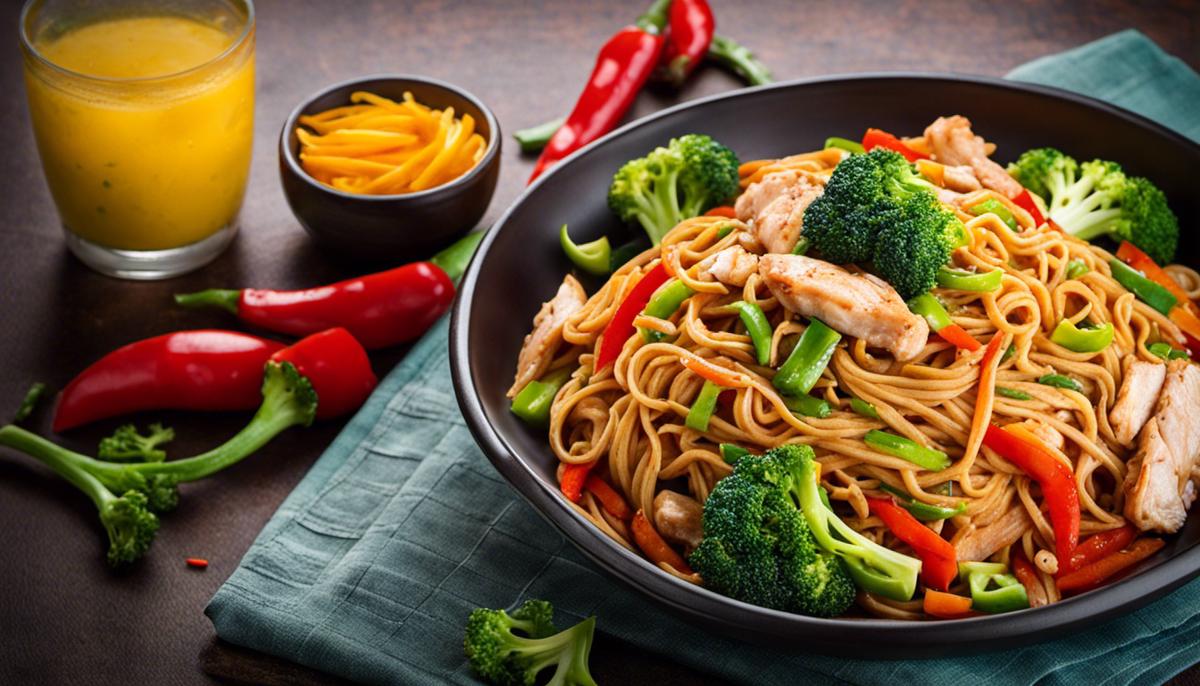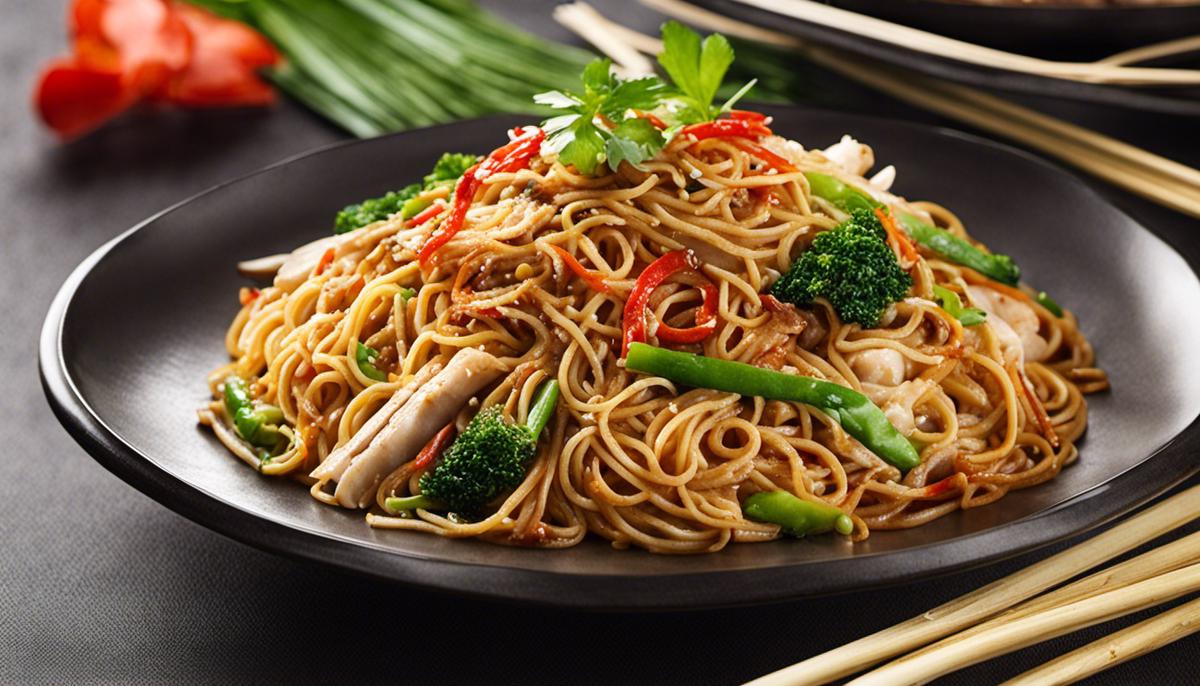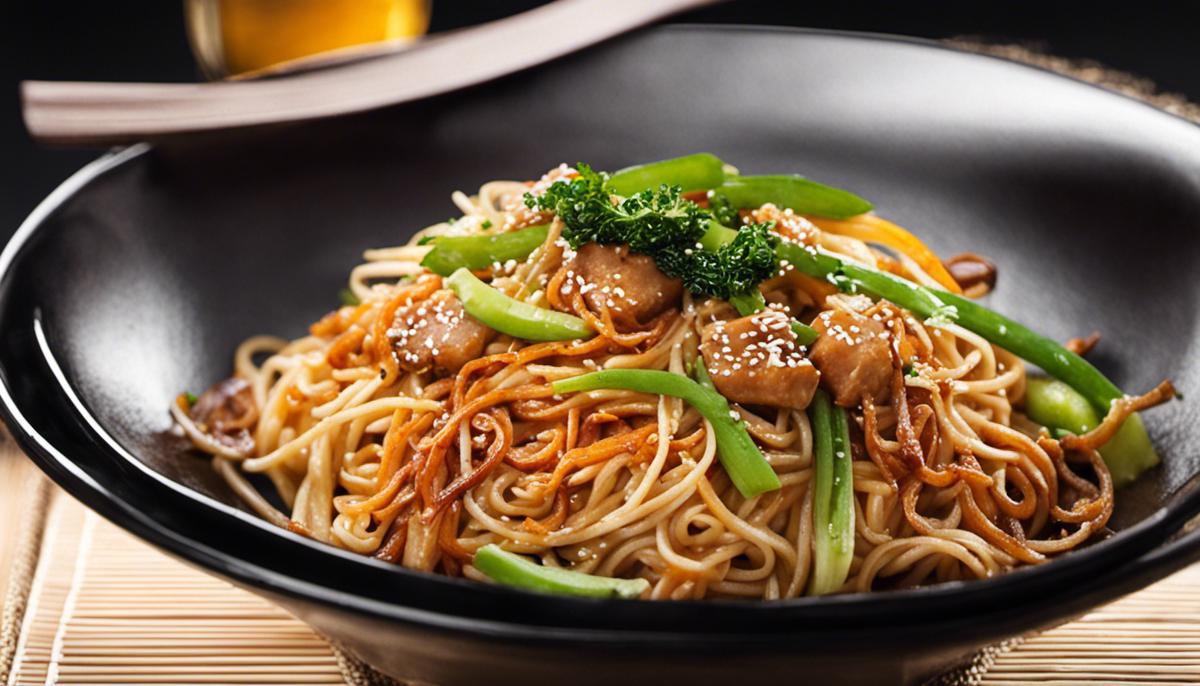Embarking on a delectable journey into the heart of Chinese cuisine, one cannot miss the rich, savory, and universally loved dish, Lo Mein. This noodle delicacy, significant in its simplicity yet profound in its cultural implications, has worked its way into countless kitchens worldwide, tantalizing taste buds and winning hearts. Traversing a timeline that winds through centuries of food fashioning, we shall explore the fascinating history of Lo Mein, from its early beginnings to its modern adaptations. As you cozy up and read on, imagine the captivating scent of perfectly balanced noodles, the sight of fresh, colorful ingredients, and the textures that playfully please your palate as we decode the traditional techniques and modern adaptations behind this internationally embraced dish.
The History of Lo Mein
The Beguiling Journey of Lo Mein Noodles – From Humble Origins to Global Fame
Whether it’s the aged authenticity of a rustic Italian pasta or the exotic allure of Indian curry, each dish carries its own set of stories from a particular corner of the world. Among the palate of global cuisine, a perennial favorite stands out – the delectable Lo Mein noodles. Replete with character and flavor, Lo Mein noodles are not just a dish; they are an experience—a tale of travel that spans generations, peoples, and continents.
The Lo Mein Story begins, predictably enough, in the sprawling food landscape of China. These gleaming tangles of noodles are a beloved staple in the vast and diverse Chinese culinary panorama. The name “Lo Mein” translates quite literally to “stirred noodles,” underlining the simplicity of its creation. Traditional Lo Mein is made using egg noodles, which are quickly boiled and then tossed into a wok, meeting a panoply of ingredients – veggies, seafood, meats, soy sauce, all getting swiftly stir-fried to create a dish that’s as versatile as it’s flavorful.
Like many other popular foods, the roots of Lo Mein are steeped in the humble kitchens of the agricultural heartlands of Canton, sometimes known as Guangdong province. The farmers understood the art of pairing the bounty of nature with the hearty flavors of seafood and meats, creating a balanced, nourishing dish that lent itself beautifully to the communal style of dining popular in rural China.
As with most good food, Lo Mein didn’t remain a local secret for long. From the rural villages in Canton, the Lo Mein wave moved Northward, particularly influencing the culinary culture of Hong Kong. It was in the bustling streets of Hong Kong that Lo Mein was able to truly evolve and diversify, incorporating a range of flavors inspired by global cuisine and the city’s unique mix of cultures.
The significant Chinese diaspora in the 20th century largely helped to globalize the dish. As Chinese immigrants embarked on new lives in diverse corners of the world, they carried within their hearts and suitcases the essence of their culinary heritage. Lo Mein started appearing on menus in American, and later European, restaurants, sealed with approval by foodies who relished its versatile, adaptable nature.
Yet, it wasn’t just a copy-paste job. As is the magic with food and its ability to adapt, Lo Mein began to take on local characteristics in each region it was introduced to. For instance, Americanized Lo Mein is typically heartier, packed with more meat and vegetables than its more traditional counterpart. In Europe, the presence of locally-sourced seafood influences its flavor and composition.
From humble farmhouse beginnings to the glitzy world of international cuisine, Lo Mein has been on a journey of evolution that doesn’t seem to be ending any time soon. Its global popularity continues to rise, with new flavors and variations emerging that are sure to tantalize taste buds.
In essence, when the next plateful of luscious, steaming Lo Mein noodles meets the table, remember, it’s not just a delicious dish set before you. It’s a culinary chronicle that showcases humanity’s love for food that transcends boundaries, tells stories, and connects us all in an ode to flavors, tastes, and the simple joy of eating.

Ingredients and Making of Lo Mein Noodles
The art of crafting perfect Lo Mein noodles demands an exquisite balance of virtuosity, technique, and the finest ingredients
. It is more than just a culinary endeavor, it is a manifestation of a rich culinary heritage, deeply rooted in Chinese history, now thriving globally.
Casting light on the perfect Lo Mein elucidates the fact that it is not just about the noodles. These elegantly curated strands are indeed a key player, but it’s the dance between the noodles, the sauce, and the assortment of ingredients that brings the magic to life.
Center stage in the making of the Lo Mein noodles is the texture. Traditionally, egg noodles with a slightly thin diameter are used. They are firm to the bite, offering a pleasing chewiness and an excellent conduit for soaking up the rich sauces. Whether these noodles are hand-made or store-bought, they should be cooked just to the point of al dente, to prevent them from turning soggy during the stir-frying process.
Now, to the orchestra of the flavors, the sauce – the heart and soul of any Lo Mein dish. Crafted with the precision of a virtuoso, this sauce is often a harmonic blend of dark and light soy sauces, sesame oil, and hoisin or oyster sauce. This versatile sauce has the power to either elevate or bring down the entire ensemble. Every dash added brings a new taste dimension – salty, sweet, umami, and a hint of smokiness, all intertwining into a melody of flavors.
The paintbrush in our culinary portrait of Lo Mein is the array of ingredients that color and form this dish. Traditionally, the choice of ingredients oscillates between an assortment of vegetables, meat, or seafood, tossed charmingly with the noodles and sauce. The ingredients are stir-fried in a wok to a perfect blend of crunchiness and succulence, impressive enough to tantalize the staunchest of taste buds.
The secret to getting Lo Mein right lies in the stir-frying technique. The wok – a spherical cooking vessel used extensively in Asian cuisines, plays a critical role in this process. The heat from the wok facilitates the quick, high-temperature stir-frying required for Lo Mein, ensuring each bite holds the essence of “wok hei” or, “the breath of the wok”, a highly sought-after attribute in Chinese cuisine that brings an irresistible smoky, nuanced flavor.
Finally, the presentation of Lo Mein signifies a harmonious blend of color, texture, aroma, and flavors that simultaneously captivates the eyes, nose, tongue, and heart. The colorful and vibrant ingredients mixed with the glossy noodles serve not only as a feast for the palate but also for the soul.
Crafting the perfect Lo Mein noodles, as it turns out, is akin to composing an orchestra, with each element playing a key role, creating a wholesome symphony of flavors and textures. Yet, the true beauty of Lo Mein lies in its flexibility – it allows endless possibilities for innovation and adaptation, while faithfully maintaining its fundamental spirit. An embodiment of unity in diversity, it truly exemplifies the global terrestrial language – the language of food, bridging people together, one savory strand at a time.

Variations of Lo Mein Noodles
Stepping into the diverse terrain of Lo Mein variations offers an exciting peek into the gastronomical journey of this beloved noodle dish. The ubiquitous Lo Mein has wormed its way into countless kitchens worldwide, becoming a symphony of flavors echoing the merging of cultures in our global culinary arena.
One might find their taste buds teleporting to the culinary landscapes of Malaysia, where the Lo Mein is excelently represented by the vibrant ‘Mee Goreng.’ Here, an intense balance between sweet, spicy, and savory holds sway, with prawns, cubes of firm tofu, and a friend egg crowning the ensemble.
In the rain-laced streets of Manila, Philippines, the Lo Mein riffs take cues from Spanish influences, making its own statement with ‘Pancit Canton.’ Like the buzzing metropolis, it brims with julienned vegetables, thin slices of meats, sunshine-hued calamondin and a trail of soy-based sauce.
Nonetheless, the unique fusion of flavors targeting the Philippine palate seamlessly blends with the Lo Mein’s origin story. Other Asian countries have a similar story, like South Korea, whose Jajangmyeon stains the palate with its luxurious black bean paste, chunky bits of pork, and a delightful squiggly nest of Lo Mein transformed magically by a dance in searing heat.
The narrative continues across the pond, to the land of the free and the brave. America’s adaptation of Lo Mein leans toward a heavier, indulgent profile. More saucy than oily, it punches robust flavors with the generous addition of protein, colorful veggies, and a garlic-infused sauce, at times jazzed up with the likes of oyster or hoisin.
Europe, the melting pot of diverse cultures, offers a new take on Lo Mein, demonstrating its versatile appeal. Some versions even cater to those driving the vegan trend forward, replacing the traditional oyster-based sauce with soy-sauce and inviting a colorful parade of vegetables to soak in a wok’s fiery embrace.
New Zealand and Australia have equally embraced Lo Mein, translating its inherent flexibility into versions catering to local palates. The Kiwi and Aussie renditions play on levels of sweetness, smokiness, and incorporate locally sourced produce.
Even the heat-ridden Middle East has tenderly accepted Lo Mein, featuring dishes that lean toward the spicy end of the spectrum, often paired exotically with lamb or a dash of tahini to soften the heat.
In every corner of the world, Lo Mein continues to evolve, proving its unwavering international appeal. Exquisite and complex in simplicity, it’s a culinary chameleon adapting to regional taste profiles, yielding to local produce availability.
Ultimately, the intertwined tale of Lo Mein’s global journey is more than just a piece of noodle drenched in layers of flavorful sauces or the smoky flavor integral to its stir-fried nature. It is a narrative of shared meals, vibrant gatherings, a bridge connecting one culture to the next. Across borders and through centuries, Lo Mein is cordially inviting everyone to the table to experience and share the universal love for food.

Pairing Lo Mein Noodles
Delicious Pairings with Lo Mein Noodles
No matter where in the world one might be, the adaptable and mouthwatering charm of Lo Mein noodles knows no boundaries. It doesn’t matter if you’re tucked away in a street food stall in Hong Kong, eager to mop up the last streaks of sauce from that takeaway box, or serving up a family feast in a Detroit kitchen, Lo Mein noodles hold a certain magnetic pull that is universally appealing.
Lo Mein’s inherent magic lies in its simplicity. The soft yet sturdy yolk-based noodles lend themselves to fantastic spice adventures and culinary experimentation. They’re like a blank canvas, waiting for fresh flavors and ingredients to bring them to life. A splash of dark soy sauce, a sprinkle of five-spice powder, or a handful of crisp, fresh vegetables can turn them into a delightful palette of flavor.
Stir-fried shrimp or prawns make an exceptional partner to Lo Mein. The sweetness of the shrimp stands in delightful balance with the savory undertone of the noodles, while the slightly crisp exterior gives way to a tender interior that’s simply delectable.
Bok Choy is another excellent pairing choice when it comes to Lo Mein noodles. This delicate, Chinese cabbage, subtly flavored and crisply fresh, adds a dimension of texture to your noodle dish. Quickly stir-fried in the wok and mixed in with the noodles, Bok Choy soaks in all the flavors yet retains its original crunch, providing a pleasurable contrast with each bite.
Then there is the omnipresent chicken, a universal crowd pleaser. Whether it’s thinly sliced chicken breast marinated in a rich hoisin sauce or cubed chicken thigh dressed in oyster sauce, the result is always the same – deliriously happy tastebuds.
For a vibrant pop of color and flavor, bell peppers are an ideal addition. They sport a delightful crunch and natural sweetness that perfectly counters the succulent protein and savory noodles. Opt for a colorful array of red, yellow, and green bell peppers for the maximum color and flavor impact.
Lastly, let’s not forget the rich, hearty addition of mushrooms. Shiitake, Cremini, or even a blend of various mushroom types brings an earthy depth to the dish. Their softness, when cooked, adds a layer of complexity to the texture of Lo Mein, enhancing the overall eating experience.
Whether it’s merely spicing up a family dinner, testing out new flavors in a restaurant, or trying to recreate every version of Lo Mein out there, the best part is the limitless potential for thrill and discovery every time your fork twirls those delectable noodles. So tie up the apron, heat up that wok, and let the delightful adventure of pairing with Lo Mein noodles begin. After all, food is a universal language that knows no boundaries. Happy stir-frying!

Plates around the world are graced by the presence of Lo Mein, each one telling a story of traditions, adaptations, and culinary creativity. The versions of this beloved dish mirror the rich tapestry of local tastes and cultural influences, serving as a testament to its enduring appeal and universal enjoyment. Unarguably, the art of preparing a dish like Lo Mein is a gastronomic adventure, bearing testimony to the power of simple ingredients to create phenomenal flavors. And coupling it with complementary sides, beverages, and desserts only magnifies this joyful experience. The next time you slurp on those glistening noodles, remember the journey they’ve been on, revel in the culinary connections, and take a moment to appreciate the global gastronomy that Lo Mein represents.
